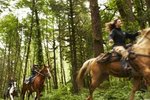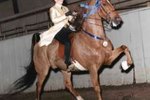Bouncing in the saddle at any speed can leave you with a sore backside. At a gallop it can be dangerous as well, as it leaves both you and your horse off balance, increasing the chances of him tripping or you falling. If you're bouncing around at a gallop, work on a proper position in the saddle and building key muscles to help you maintain it.
A Proper Seat
When you're sitting properly in the saddle, your ear, shoulder, hip and heel should be in alignment. Rest the balls of your feet lightly in the stirrup and flex your ankles so your heels are lower than your toes. Don't push down on the stirrup, extend your legs forward or squeeze the horse with your lower legs. Adjust your basic position for the gallop by putting your weight on your heels, leaning forward slightly from the hips and rising just above your saddle with bent knees. Keep your heels in alignment with your hips to maintain your balance. You can get a feel for the correct position on a horse that is standing still by putting your arms behind your back and rising from the saddle. Have a partner hold your horse's reins while you do this.
In the Gallop
Master remaining in a proper saddle position at a walk, trot and canter before attempting to gallop. Your horse stretches out his nose and lengthens his back at a gallop, making him difficult to control at a gallop than any other gait. Make sure he's well under control at lower gaits before attempting to gallop. Ask him to break into a gallop from a controlled canter.
When riding in the canter, lean forward slightly from your hips before signaling your horse to increase speed. Keeping your weight over your feet helps the horse maintain his balance because you're weight remains over his center of gravity. Your head should be up and still, with your eyes focused on the course ahead of you. Make sure your position is comfortable to hold for the duration of galloping without pulling on the reins to maintain balance. Some riders shorten their stirrups a couple of notches to find the most comfortable position for the gallop.
Get Fit
Balance, strength, flexibility and endurance all figure into helping you ride a gallop without bouncing around in the saddle. Practice exercises out of the saddle for strengthening your core and developing toned and flexible ankles, knees and hips. A swiss ball offers one of the most versatile ways to work out the muscles you'll need for riding at a gallop. Place it behind your back against the wall to do partial squats to develop your glutes and the back of your thighs. Place your feet horse-width apart to train the exact muscles you'll need. Use a ball the same approximate width as your horse to sit on and practice aligning your heels, hips and ears. Develop core muscles by doing pelvic circles, side to side movement and forward and back movement. Heel and toe raises develop ankle strength and flexibility to keep you stable when your horse is at a gallop.
Writer Bio
Indulging her passion for vacation vagary through the written word on a full-time basis since 2010, travel funster Jodi Thornton-O'Connell guides readers to the unexpected, quirky, and awe-inspiring.





